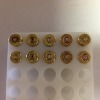OK, let's make a list of possible explanations and pros and cons of those theories:
1. Primers not seated, too much of hammer/firing pin force being used to complete seating.
Pros: Happens to reloaders (even good ones) from time to time, not inconsistent with evidence of some strikes being deeper than others.
Cons: You're an experienced reloader and say they're all below flush.
Possible test method(s): Take some of your unfired reloads from same loading sessions and carefully examine for any high primers; load another batch paying particular attention to this variable and holding out any that don't have primers that aren't deeply seated.
2. Primers bad from factory.
Pros: Anything is possible.
Cons: Probably explanation of last resort.
Possible test method(s): Try another batch of primers from different carton.
3. Primers bad as installed - damaged/contaminated
Pros: Consistent with variable ignition
Cons: Somewhat inconsistent with visibly different depth of strike.
Possible test method(s): Pull some misfires, examine primers for missing priming compound, discoloration, clumping of powder.
4. Hard cups on primers
Pros: Different manufacturers have different hardness of primer cups; consistent with apparently light strikes on one brand of primers, apparently good strikes on others.
Cons: Speer Lawman probably uses CCI primers, and CCI are known to be fairly hard; Winchester not generally reputed to be harder than CCI, though not soft like Federal.
Possible test method(s): Try a different brand of primer.
5. Primer intolerant of off-center strikes.
Pros: Would be consistent with inconsistent ignition, and firing pin does appear to strike well off-center.
Cons: Is this a thing? Never heard of it...
Possible test method(s): Try a different brand of primer; try reloads in different handgun.
6. Oversized ammo not properly headspacing, firing pin energy absorbed driving cartridge into chamber.
Pros: Not inconsistent with reloads giving trouble, factory ammo running fine.
Cons: You say passed plunk test.
Possible test method(s): Get case gauge cut to SAAMI minimum and check; try reload in another gun known to have a tight chamber; repeat plunk test with careful attention to full seating.
7. Underlength cases not headspacing on rim, extractor holding cartridge to face but loosely, allowing cartridge to shift and absorb FP energy.
Pros: I've heard people claim this can happen.
Cons: I've not actually seen this happen.
Possible test method(s): Measure cases of misfires, see if consistently shorter than rounds that fired.
8. Gun's hammer spring too weak.
Pros: Consistent with light strikes.
Cons: Doesn't explain why factory ammo will run, given suspected hardness of factory ammo primers (CCI - see above).
Possible test method(s): Try a couple more factory ammo types; replace hammer spring with heavier weight.
9. Problem with firing pin/firing pin channel/firing pin retaining plate/etc.
Pros: Consistent with light strikes, possibly intermitent (alignment of burs, FP catching sometimes but not always)
Cons: Can't replicate with factory ammo. (But maybe small sample size? Maybe different conditions (e.g., testing in air conditioned indoor range causes metal to shrink??) generates different results?)
Possible test method(s): Carefully inspect FP, FP channel, FP plate; keep trying to induce malfunction with factory ammo under same conditions as reloads manifest.
That's all I can think of right now.




